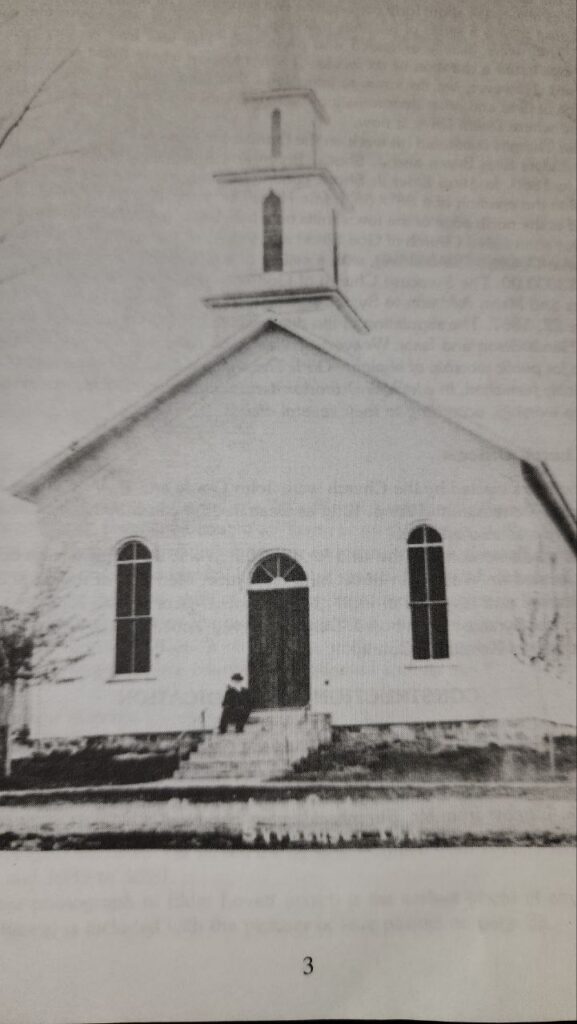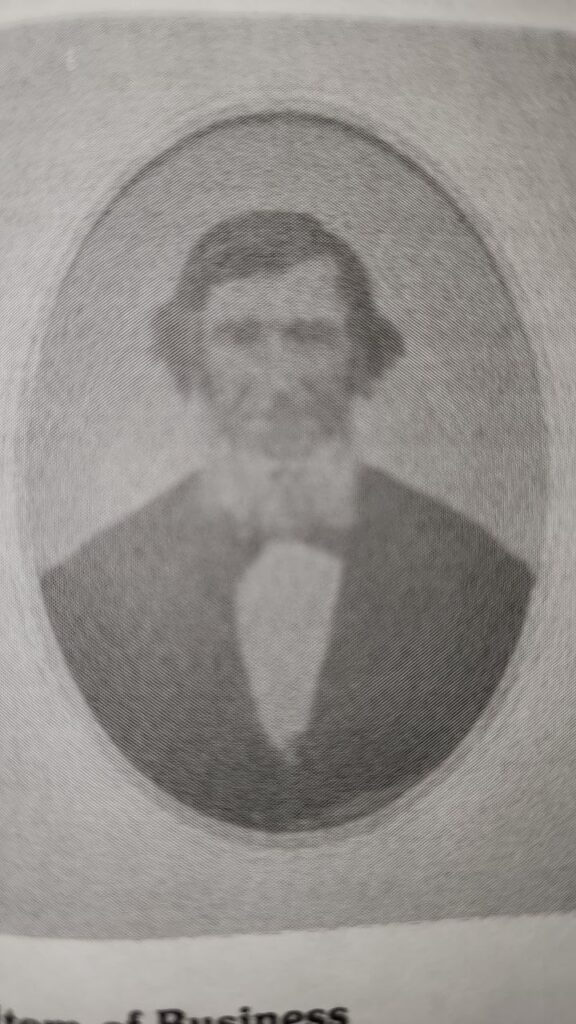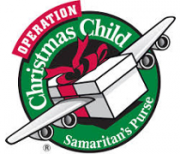THE DENOMINATION AND ITS BEGINNING
The denomination known as the Churches of God of North America had their beginning under the preaching of John Winebrenner.
John Winebrenner was born March 25, 1797 in Frederick County, Maryland. His parents were of German descent and members of the German Reformed Church. When John became of age he went to Dickison College and studied under Samuel Helfenstein of Philadelphia. He studied theology for three years and was ordained a minister in 1820 at a meeting of the synod in Hagerstown, Maryland.
John Winebrenner was assigned to the German Reformed Church at Harrisburg, Pennsylvania. While preaching at Harrisburg Winebrenner’s religious views changed. He began practices contrary to the beliefs of the Church. Charges were brought against him by the Vestry. Naming a few of the charges are the fact that he had been attending Methodist meetings and sometimes had preached to them. He held too many prayer meetings and conducted them with too much noise and confusion. He allowed persons to groan during prayer while others responded with amens.
To reach a compromise the Vestry ask that he preach for them and not to other congregations. Not to hold more than one prayer meeting a week and not keep it up later than nine o’clock. John Winebrenner replied, “I will not consent to the arrangements, for I am a freeman, preach a free gospel, and will go where the Lord calls me to go.“
The Sunday following this meeting which was in the Spring of 1823 he found the doors of the Harrisburg Church locked against him. With about half of the membership which stood with him they walked to the banks of the Susquehanna River about two blocks away and held a service. Thus the movement known today as the Churches of God of North America was born.
From this humble beginning on the banks of the river a “revival fire” started in Harrisburg that spread in all directions. Around 1826 the first Church was organized in Harrisburg. This was followed by numerous other organizations of Churches in other localities.
People of German descent from Maryland and Pennsylvania began to leave the crowded lands of the East and travel to the fertile lands of the West in Ohio and later Indiana. The “Winebrennarian” Preachers sometimes traveled with these families and built places of worship in the new communities. While others were “called” as missionaries and went later to attend to the spiritual needs of the pioneers in these lonely settlements.
To Indiana
By the year 1842 the Eldership (conference) which had been formed in Ohio extended its work into Adams County, Indiana. In 1850 the work by the missionaries had spread into Huntington, Allen, Wells, Noble, Whitley, Dekalb and LaGrange Counties.
To Kosciusko County
The earliest record of Church of God activity in Kosciusko County was the convening of the 11th Indiana Eldership, October 27, 1856 at Turkey Creek (township?), Kosciusko County, Indiana
Lake Bethel
This meeting probably was conducted in the neighborhood where Elder George Thomas is credited with bringing the WORD to Kosciusko County in 1858. He organized a Church at the corner of what is now county roads 950 East and 1100 North on the east side of Lake Wawasee. This Church was known as Lake Bethel. Fieldstone placed by the builders in a rectangular position is all that remains of the Church’s foundation. A country school was located across the road north of the Church. To the east of this location is a cemetery with the names of many pioneers inscribed on the gravestones. Among them is a monument to the memory of Nathaniel “Natty” Crow who was an early settler of that area. When this Church became nonexistent is not known. Records show that in 1874 Elder Bumpus, a circuit rider, held a meeting at Lake Bethel. In 1916, Rev. Floyd Hedges was the pastor assigned to Lake Bethel. According to old Eldership Journals, Pastor Daniel Young was preaching at Lake Bethel in 1923 with a Church budget of $20.00. Carl Hadley states he remembers the Church was still standing but in need of repair in the late 1930s. Some say it was destroyed by fire.
Elder John Winebrenner Dies
At a time when the Churches of Northern Indiana were beginning to flourish, sad news came from the East. The hard working founder of the denomination who had been in failing health for more than a year passed away. His death occurred September 12, 1860. He was laid to rest in the Harrisburg, Pennsylvania cemetery. Buried in the city where just thirty-seven years before he had preached to a group of followers on the bank of the Susquehanna River which was the beginning of the Churches of God.
THE CHURCH ON THE HILL
Missionary zeal around the time of the Civil War was at a peak. Camp meetings were held in the summers and revivals were held in the winters. Many new Churches were started and many new Church-houses were built. Elder George Thomas who had previously organized and started the Lake Bethel Church was called to Syracuse in 1863. The village of Syracuse had a population of over three hundred persons. It was located on the western shore of Syracuse Lake. The community boasted of two hotels, a grocery store, general store, blacksmith shop, a water-powered flour mill and a medical doctor. Missing from the scene was a House of Worship.
A Church Is Born
At the end of a protracted meeting held in Syracuse in March of 1863 by Elder Thomas resulted in about forty conversions and baptisms. The term protracted used in this sense means a series of religious meetings held mornings, afternoons and evenings. They were usually extended and prolonged. This was true as the Syracuse meetings lasted a duration of six weeks. It is not known where these converts were baptized. However, we do know at later dates that many new Christians from the Church of God and other denominations were baptized in the old mill race which was located where Dolan Drive is now.
Elder Thomas continued his work on the Syracuse mission field until he was replaced by Elders Elias Bryan and J. Shock. Bryan and Shock served the Church from 1865 to 1866. In 1866 Elder J. Shock continued the Syracuse work and was successful in the erection of a 38′ x 56′ frame House of Worship. This new building was located at the north edge of the town limits on a hill. The street (Washington Street today) was soon called Church of God Street and was listed that way in an 1874 atlas of Kosciusko County. This building, with a ceiling of eighteen feet was built at a cost of about $3000.00. The Syracuse Church of God occupies lots number 2 and 5 of the DeFrees and Mann Addition to Syracuse. The lots were deeded over to the Church October 22, 1867. The stipulation of the deed was that, “Said trustees (John Gordy, Henry Hendrickson and Isaac Weaver) or their successors will erect and maintain a building for public worship of almighty God. The building to be not less than 30′ x 50′, comfortably furnished, in which all Orthodox denominations of Christians shall be permitted to worship, according to their several creeds.“
Early Church Officers
Other officers elected by the Church were John Gordy and R. V. Cory as Elders, with Harvey Veneman and Amos King as Deacons. As you may have noticed, Mr. John Gordy was also a trustee.
Mr. DeFrees who donated the land for the Church was owner of a large flour mill that was located on West Main Street at the mill race. Members of the early Church were interested and involved in local government. Deacon Amos King was later a member of the Syracuse town board. Deacon Harvey Veneman was a former County Commissioner of Kosciusko County.
CONSTRUCTION AND DEDICATION
The construction of the Church was during the years of 1866 and 1867. In stories written about their grandfather, Pearl Harlan Applegate and Mabel Strombeck Mc Cleary both say that he (Charles H. Strombeck) furnished the rough timber for the framework. Lumber from Mr. Strombeck’s trees had been a big part of its construction. Charles Strombeck was a very early member of the Church. Charles V. Smith, grandfather of Robert (Smitty, the electrician), Smith plastered the walls of the sanctuary. It being completed in the fall of 1867 the Indiana Eldership (conference) convened at the new facility for their 22nd annual meeting. On Sunday morning, October 13th, the dedicatory service was conducted by Elders George Smith and J. S. Shock. The town of Syracuse now had a place to worship in the beautiful new white “Church on the Hill.”
Item of Business
An item of business of the Indiana Eldership while meeting in Syracuse in 1867 was the temperance committee sought to “impress on the minds of the brethren in the ministry the duty to use all their influence and power against the traffic and use of intoxicating spirits.” In the class of beverages it included “not only those manufactured from corn and rye, but such as the wine from currants, grapes, elderberries and rhubarb, which at this time are quite fashionable in our domestic circles.” The use of tobacco was denounced as “a dirty, filthy, useless and expensive practice. And all Church of God people are counseled to dispense with its use.”
Ordination Service
An ordination service was held during the 1867 Eldership at the new Syracuse Church. William Wesley Lovett, 28, a native of Canton, Ohio, was ordained as a minister of the Churches of God.
As a “circuit rider”, Elder W. W. Lovett pastored the Church where he was ordained, three different times. He served the Syracuse Church from 1872 to 1873, 1880 to 1883, and 1889 to 1890.
A rare photograph of Elder Lovett (which is the earliest photo of any pastor we could locate) is included with the pictures of later pastors on page 25.
OTHER PLACES OF WORSHIP
The question as to where the Church of God worshipped before the erection of the “Church on the Hill” has been answered. It was assumed that the new congregation worshipped in a public building or buildings wherever they could. In a July 1913 issue of the Syracuse Journal is an obituary of Zylphia Smith, the wife of Charles V. Smith. The article stated that Mrs. Smith “was converted June 14, 1864, baptized by Elder George Thomas January 20, 1865, united with the Church of God at Meloy’s Schoolhouse, later at Syracuse.“
Pearl Harlan Applegate writes: “The Church of God was holding a series of meetings at the Meloy Schoolhouse on the Stringtown Road west of Syracuse. There Grandfather (Charles H. Strombeck) received Christ as his personal Savior and demanded baptism the same night as his conversion. It was winter, but he would not wait until spring, so he was baptized in the “run” that night. After his baptism, he stood in his stocking feet in the snow. Someone said, “Father Strombeck, you had better put on your boots,” but he replied, “No my foots are not cold.“
The Meloy School, ca. 1911. This school was located between county roads 250 and 300 on the Milford/Syracuse road. A frame school house occupied the site prior to the brick building shown in the picture. The Church of God (Syracuse) conducted Church services in the frame structure before the 1867 dedication of the Syracuse “Church on the Hill.” Many of the parents and grand parents of the children in the photo were members or attended services when the Church met in the Meloy school.
The picture was loaned to us by Mr. Marion C. Deeter, age 86, of Milford. Mr. Deeter graduated from Meloy School in 1916. The students in the picture are identified as follows: Front Row: Joy Cory, Edith Bushong, Gladys Coy, Lucille Callender, Dora Schuder, Charlotte Meloy, Unknown, Kenneth Bushong, Guy Hoover.
Row 2 – Marion Deeter, Martin Hoover, Albert Razor, Earl Darr, Ethel Schuder, Ruth Cory, unknown, Oren Hoover.
Row 3 – Lilly Bender, Marie Cory, Mabel Bushong, Mary Traster.
Row 4 – Guy Cory, A. W. Stout, Teacher, Claud Insley, Ernest Meloy, Fred Traster.
The Meloy Schoolhouse was located on the south side of the Milford Road at the entrance of the Sturm and Dillard gravel pit. It was just east of the railroad spur track which at one time crossed the road.
SHARING THE FACILITY
The Church board, in keeping with the request of the deed to allow other denominations to worship in the new building is recorded in the Church records. On December 7, 1870, a meeting was held for the purpose of electing a sexton “to keep the Church-house in order for the coming year.” The cost to keep the Church for the year was eighty dollars. The Church of God agreed to pay thirty-one dollars and twenty-five cents. The balance would be equally divided between the Methodists, United Brethren, Lutheran and Dunkards. The cost of a sexton went as high as ninety-five dollars for a year’s service. This sharing of the Church cost continued for years until one by one the other denominations grew to the point they could erect their own Houses of Worship.
Only one reported mix-up resulted in the use of the Churches’ facility occurred on April 26, 1874 on Easter Sunday. The Dunkards had appointed the same time as the Church of God. How the two groups solved this problem is unknown. The record states that “Elder Martin preached.” The Church of God seemingly won out on the use of the building.
In 1875 a motion was brought before the board concerning a problem with the sexton. The motion was that “the sexton shall not use any bad or unbecoming language in the Church House. Motion carried.” Sometimes the sexton did not take care of his duties. In a meeting in 1885 a motion by James Brady “that if Jacob Slabaugh doesn’t come home in four weeks from present date there be another sexton hired in his sted.” The struggling Churches had financial problems. Monies for the support of the sextons was not abundant. One brother agreed to take the job as sexton and “take his chances” on getting paid.
EARLY CONTRIBUTORS
The following portion is dedicated to the memory of four men who were instrumental in starting the Church and keeping it going during the early years.
Jacob Ott Early Elder
Around the year 1847 a young farmer of German stock and his wife settled on the land just north of the village of Syracuse, Indiana. This land roughly encompassed the area east of the Huntington Road, north to the Elkhart County line, south to the village limits and followed the meanderings of the lake east through Indian Hills.
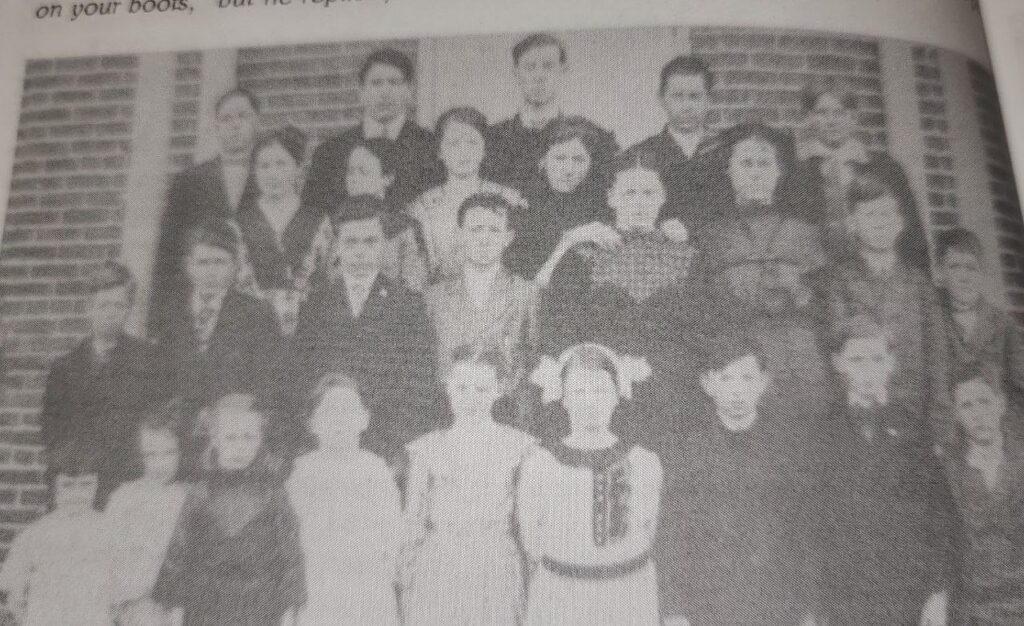
Jacob Ott, 28, and his wife, Sarah, 26, were married September 7, 1841 in Preble, County, Ohio. The Otts, with their young family, had just arrived from the old home, in Preble County, Ohio to make a home in this new land.
After a number of years of hard labor, a productive farm was carved out of this wilderness. Jacob and Sarah farmed the high land along the county line, while using the rougher part near the lake for grazing their animals. This area next to the lake was ideal because of the abundant water supply.
A walk through the Ott family plot in the Syracuse Cemetery will attest to the fact that the early years were not kind to Jacob and Sarah. At least six infant graves are located there with the age of the eldest to be only four years old. The children who survived those hard years and grew to adulthood were: John A., David, Sarah M. George W., and Almeda Ott.
DESCENDANTS OF JACOB AND SARAH (SHULL) OTT
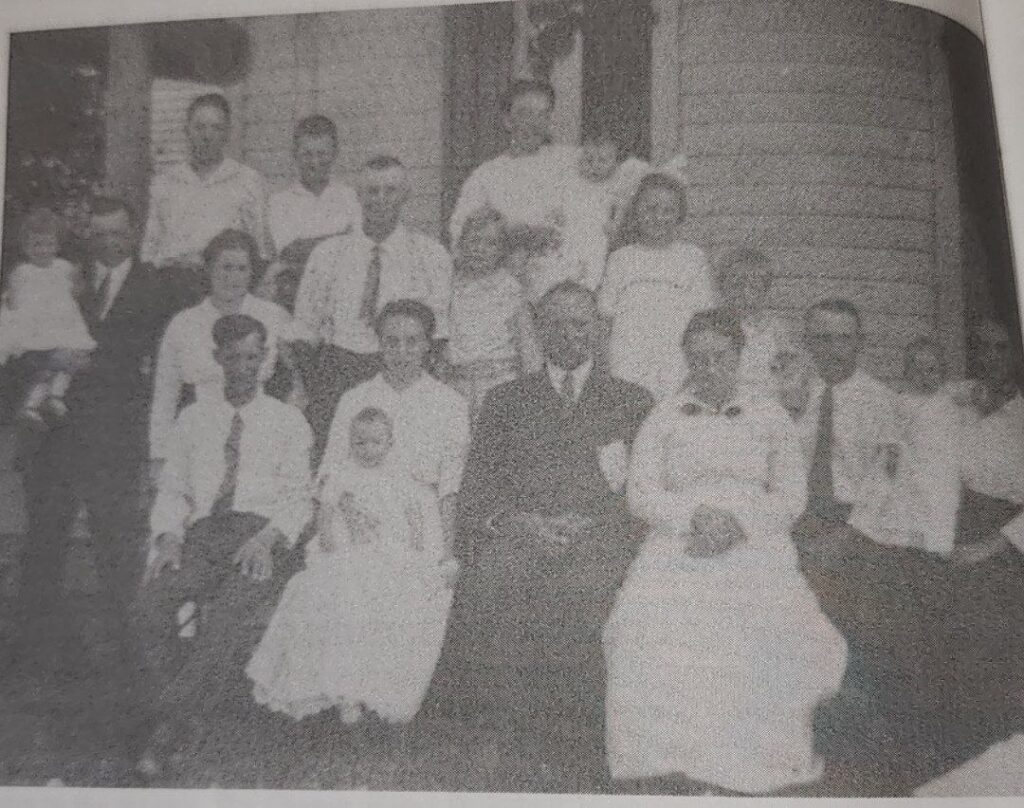
THE JOHN AND ALMEDA (OTT) WARD FAMILY
Row 1 – Roy Lingenfelter, Lena (Ward) Lingerfelter, holding Catharine Lingerfelter, John Ward, Almeda (Ott) Ward, Clee Hibschman, Virgie (Ward) Hibschman, holding Leonard Hibschman.
Row 2 – Bert Ward, holding Betty Ward, Hazel Ward, Lewis William Miller, Paul Miller, Lydia Miller, Russell Miller.
Row 3 – Roy Miller, Ben Miller, Elnora (Ward) Miller, holding Mary Miller.
Jacob and Sarah became members of the fledgling new “Church on the hill.” His leadership qualities surfaced as he was elected Elder. He served as chairman of the Church governing board starting in 1872 and was re-elected ten consecutive years. At one time, he served in the capacity of deacon for two years as well as sundry committees. Old records show that he paid a portion of his tithe with produce from the farm if actual cash was not available.
In her book, ‘Sweet Memories of Old Indianie’, native Syracusian Sarah Brown DeBra writes about her experience with Jacob Ott while attending Easter services at the Church of God in the middle 1870s. It seems that Mr. Ott had a very booming voice that could cause fear in a young child. The following is a quote from the book when little Sarah Brown is being coached by her older sister: “And you must be real still and not be afraid when Uncle Jaky Ott says Amen! Amen!”. The author continues: “And when we arrived in the village I tried to do everything just as sister had told me. But when Uncle Jaky Ott shouted AMEN! AMEN! in the Church I jumped up and looked around.”
Jacob Ott died July 19, 1886, at the age of 67 years. Sarah Ott lived well into the twentieth century. She died March 23, 1910 at the age of 89.
Not only is Jacob and Sarah the ancestors of many Otts sprinkled through this area today, but numerous other segments of families have the blood of these hardy pioneers flowing– through their veins. Some of the family names are Miller, Lingofelter, Darr, Firestone, Ward, Hibschman, McPherson and Younce.
Elder George Thomas
Founder of Syracuse Church
Elder George Thomas, one of the early pastors of the Winebrenner Churches of God, was born near Perrysville, Pennsylvania, in 1818. His parents were farmers and members of the old school Lutheran Church. He was educated in the country schools of the day. In 1840 he married Elizabeth Hamilton and the same year entered upon a religious life. In 1843 Elder Thomas and his wife moved to Miami County, Ohio, where he followed his trade of shoemaking. In 1849 he was commissioned by the Pennsylvania Eldership to go to Indiana and preach in the Miami Indian Reserve. Moving to Indiana, he purchased a small farm in Wabash County, worked some at his trade and preached in the thinly settled country. While in Indiana he received the call to go to Iowa and preach in 1856. A short time after arriving in Iowa his wife, Elizabeth, died, leaving Elder Thomas with four children to care for. Two years later he married Catherine Baker of Wabash County, Indiana. Catherine was born in Ohio circa 1835. The same year he moved to Syracuse, Kosciusko County, Indiana. While in Indiana, Elder Thomas held many responsible positions in the Eldership. After coming to Kosciusko County, Elder Thomas first organized a Church known as Lake Bethel on the Nathaniel Crow side of Nine Mile Lake (Wawasee). In 1863 George organized the Syracuse Church with forty members.
While in Syracuse, Thomas owned and lived in a house located on lot 46 on Pearl Street. This location is where the Pentecostal Church parking lot is today. Elder Thomas also owned vacant lots 31 and 32 in the same block on Benton Street.
The 1860 federal census of the Village of Syracuse list six children, four boys and two girls in the Thomas household. The ages of the children range from 6 months to eighteen years. The older children were born in Ohio and the two younger born in Indiana. In 1860 at twenty-five years of age, Catharine is only seven years older than her eldest stepchild.
Elder George Thomas is shown as having a real estate worth of $300.00 and personal property of $400.00. His occupation is recorded as Clergy-Winebrennarian.
In 1886 Elder Thomas left Syracuse and went to Centralia, Kansas, where he preached for nine years. After many trials, losses and disappointments he moved to Pleasant Hill, Missouri. While in Missouri, Elder Thomas’ health began to fail. Thinking a warmer climate might cause him to regain his health, he left his wife and children in Missouri and moved to San Antonio, Texas, April 3, 1878. For the next two months he stayed with his brother and sister-in-law who were the only ones present when he closed his long and useful life of sixty years with the dread disease of consumption. His brother testified to the family that the last words coming from his lips were “Blessed Savior.” His remains were returned to Pleasant Hill, Missouri for burial. The service was conducted by Elder Joseph Bumpus from the Indiana Eldership and former pastor of the Syracuse Church of God. Elder George Thomas, during his thirty-five years of preaching, traveled mostly by horseback, He preached in the states of Pennsylvania, Ohio, Indiana, Illinois, Iowa, Kansas and Missouri.
Joseph H. Defrees
Donated Land
A person to whom the Syracuse Church of God and the people of Syracuse owe a debt of gratitude is Joseph H. Defrees. Joseph, a descendant of French Huguenots, was born May 13, 1812 in Sparta, White County, Tennessee. He was one of nine children born to James Defrees and wife, Margaret Dougherty. He, along with his parents, moved to Piqua, Ohio, where he attended school until he was fourteen years of age. After working for three years at blacksmithing, he then learned the printers trade in the office of the Piqua Gazette. With his brother, J. D., Joseph established a Whig newspaper in South Bend in the year 1831 and sold his interest two years later. While working in merchandising in Goshen, he became involved in politics and served a part term as Sheriff. In 1849 he was elected to the House of Representatives and the Senate in 1850.
Mr. Defrees was married twice. In 1832 he married Mary A. McKinney and they were the parents of six children. Mary died in February of 1864 and in 1865 Joseph married Mrs. Margaret (McNaughton) Pearce, a native of Scotland. In his later years, Joseph and Margaret resided in Syracuse. It was during that time he and his wife, seeing the need for a place to worship, deeded lots 2 and 5 of the Defrees and Mann addition to the trustees of the Church of God. The trustees were to construct a building for “the worship of Almighty God.“
The Honorable Joseph H. Defrees died December 20, 1885 in Syracuse and was buried in Oakridge Cemetery in Goshen. His stone gives his age as 73 years, seven months and eight days.
One hundred and twenty years later the Church of God congregation still occupies the same building on the land given to them by Joseph H. Defrees and honoring his wish that it be used for “the worship of Almighty God.“
Rev. Joseph Bumpus
The Peacemaker
Rev. Joseph E. Bumpus pastored the Syracuse Church of God three times during his ministry. Born near Mansfield, Ohio, October 25, 1825, he was the son of Jacob and Nancy Bumpus.
At age 21 he came to Indiana and settled in LaGrange County. On September 10, 1848 Joseph united in marriage to Mary A. Sears. Mary, who was a native of New York, was born June 10, 1832. To this union were born five daughters and two sons.
Rev. Bumpus was admitted to the Indiana Eldership in 1865. Joseph pastored many Churches in Northern Indiana as a circuit rider. He first preached at Syracuse during the 1873-1874 year. During the 1874-1875 year he was again called to Syracuse to fill out the term of Rev. Moses Coats. Moses Coats was involved in “unholy actions” that nearly caused the downfall of the young Church. Rev. Bumpus can be credited as the one who worked diligently and successfully to unite the Church body as one.
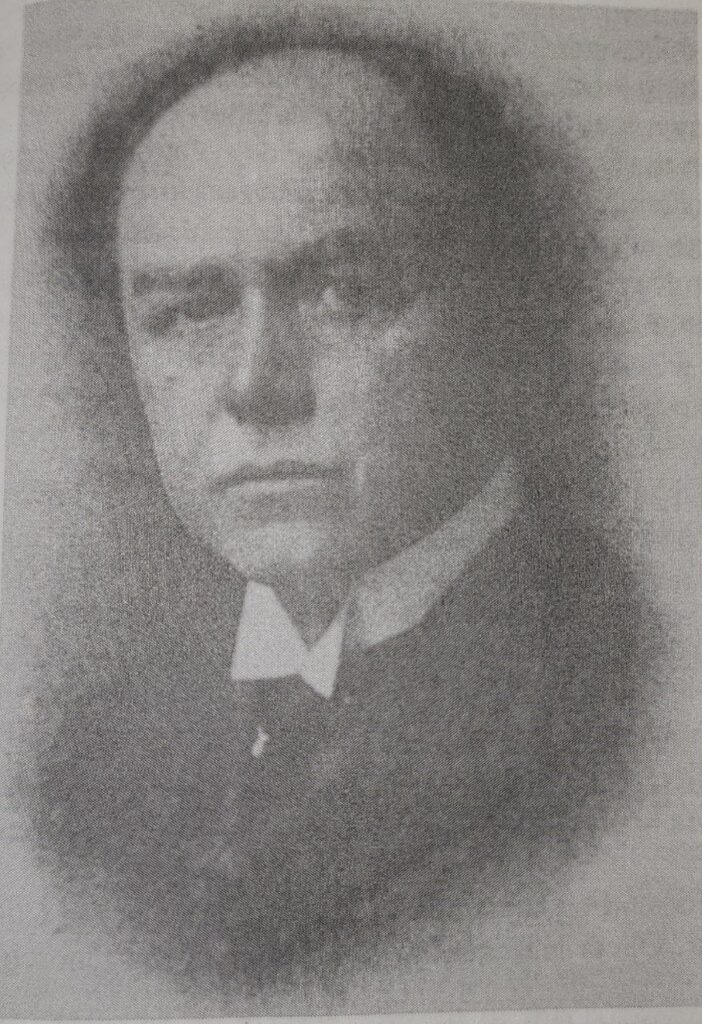
During the years of 1894 to 1898, Rev. Bumpus again served the Syracuse Church. He gave the benedictions for Syracuse High School graduating classes around the turn of the century. The graduation exercises were held in the Church of God.
Rev. Joseph E. Bumpus died October 23, 1913, just two days short of his 88th birthday. He retired from preaching when he was eighty-two. During his retirement, Joseph was employed by the town merchants as a nightwatchman.
His obituary which appeared in the Syracuse Journal, Thursday, October 23, 1913, stated: ” ‘Daddy’ Bumpus was a Familiar figure in Syracuse and was known and loved by all for his kind acts in the days when he was able to serve his Master.“
The funeral was conducted in the Syracuse Church of God after which the body was taken to Stroh, Indiana, where services were held and interment made.
CHANGES OF ORIGINAL STRUCTURE
Since the building of the original 38′ x 56′ frame structure, many changes have been made to update the facility. The first major change was the construction of a concrete sidewalk and steps for the entrance on Washington Street. This was done in 1899. The Church bell tower was originally one cubicle higher than it is now. It had a tall spire rising from it and during a storm in 1916 it was struck by lightning and eventually had to be removed.
The first Sunday School was held at the Church of God in 1873. It was not until 1917 that a 16′ x 24′ wing was built for the use of a class room on the northeast corner of the existing structure. By opening large doors into the sanctuary it could also accommodate overflow crowds.
The hitching rack, which was located on Washington Street in front of the Church, was finally removed in 1923. Mr. Oliver Hibschman, a member of the Church, has kept the chain in his possession.
The method of heating the sanctuary has changed many times since the Church was built. In the early days it was heated with a wood burning stove. The chimney that was used was located (and still is in the attic supported by heavy timbers) above the third row of pews from the altar on the east side of the room. At that time the women and children did not sit with the men during a service. The women and children sat on the side next to the stove. After the coming of the railroad to Syracuse in 1874, the burning of wood was soon phased out and coal was used to heat the building_ After the turn of the century, a coal furnace was installed in a “hole” under the sanctuary. This furnace furnished heat through one large register in the floor. A stoker was added to this furnace for the convenience of having a warm Church on Sunday morning rather than having someone arrive early and build a fire in the wee hours of the morning.
DIGGING THE BASEMENT
In 1951 a full basement was dug and a fuel oil furnace was installed with heat runs and numerous registers for distributing the heat to all parts of the Church.
This new basement area housed Sunday School classes, kitchen, restrooms, and the new oil furnace. At the same time a new front entrance on Washington Street was built at ground level. This replaced the cement steps that were put there in 1899.
The digging of the basement was at that time the biggest remodeling attempted on the structure. The work was started by Trustee Clee Hibschman and a short time later Mr. Hibschman passed away. His son-in-law, Louis Firestone, was given charge of the work. An opening was dug at the back of the Church to accommodate an elevator to remove the dirt from under the building. The dirt was hard yellow clay which made the excavating quite difficult. Walter Williams states he suggested the use of dynamite and placed the first sticks under the Church. He said he did this at lunch time while no one would be around and have less chance of accident. He wired the fuses and ran the wire to his car that was parked back of the Church near the alley. Walter went in the Church and opened all the windows so the concussion wouldn’t break any glass. He then returned to his auto and touched off the dynamite with the car battery. Mr. Williams said after taking all of these precautions he did not see Rev. F. E. Handley enter the Church. After the explosion Rev. Handley ran from the Church and told Walter that the carpet runner down the center aisle “came up this high“, gesturing about four feet with his hands. Poor Rev. Handley, scared, but not hurt, was bent over behind the pulpit picking up some papers when the dynamite was touched off. Louis Firestone said they continued the dynamite method but Rev. Handley left that year and Marion Shroyer became the pastor. Mr. Firestone said the four guys he could depend on to be there day after day were “Jiggs (Oliver Hibschman), Virgil Bobeck, Max Burley, and Dad (Chester Firestone)”. The first week of April, 1952, the plumbing was installed and Louis made a plea for extra help to pour the concrete floor. His call was answered by a large turnout of the congregation and the new basement was finished. The digging of the basement and other improvements totaled about $10,000. Most of this improvement came as a gift from the Sarah McPherson estate. Sarah McPherson was a daughter of the old pioneers Jacob and Sarah Ott.
REDECORATING AND NEW FLOOR
Hardwood floor was laid in the sanctuary in 1929. The cost of the floor was paid largely by a gift from Mrs. Sena Unrue. During the time of laying the floor, the Church held services in the school across Washington Street from the Church. At this time there occurred a redecorating of the walls and ceiling, and a beautiful picture of Christ in the garden of Gethsemane was placed on the front wall of the sanctuary. During a later renovation in 1973 the picture was covered up by new paneling.
NEW CLASS ROOMS
In 1964 two class rooms were finished. They were located above the front entrance at the back of the Church – an area that could someday be used as a balcony for overflow crowds in the sanctuary.
EDUCATIONAL WING
Ground was broken August 26, 1973, and a two story brick educational wing was built. This replaced the 16′ x 24′ room that was built in 1917. Besides class rooms, the new facility included a foyer, a nursery, restrooms, secretary’s office, baptistry, kitchen, fireplace, and a pastor’s study. During this same time, the Washington Street entrance was closed and a large cross now adorns that end of the building on the outside. The sanctuary was redecorated and new carpet laid.
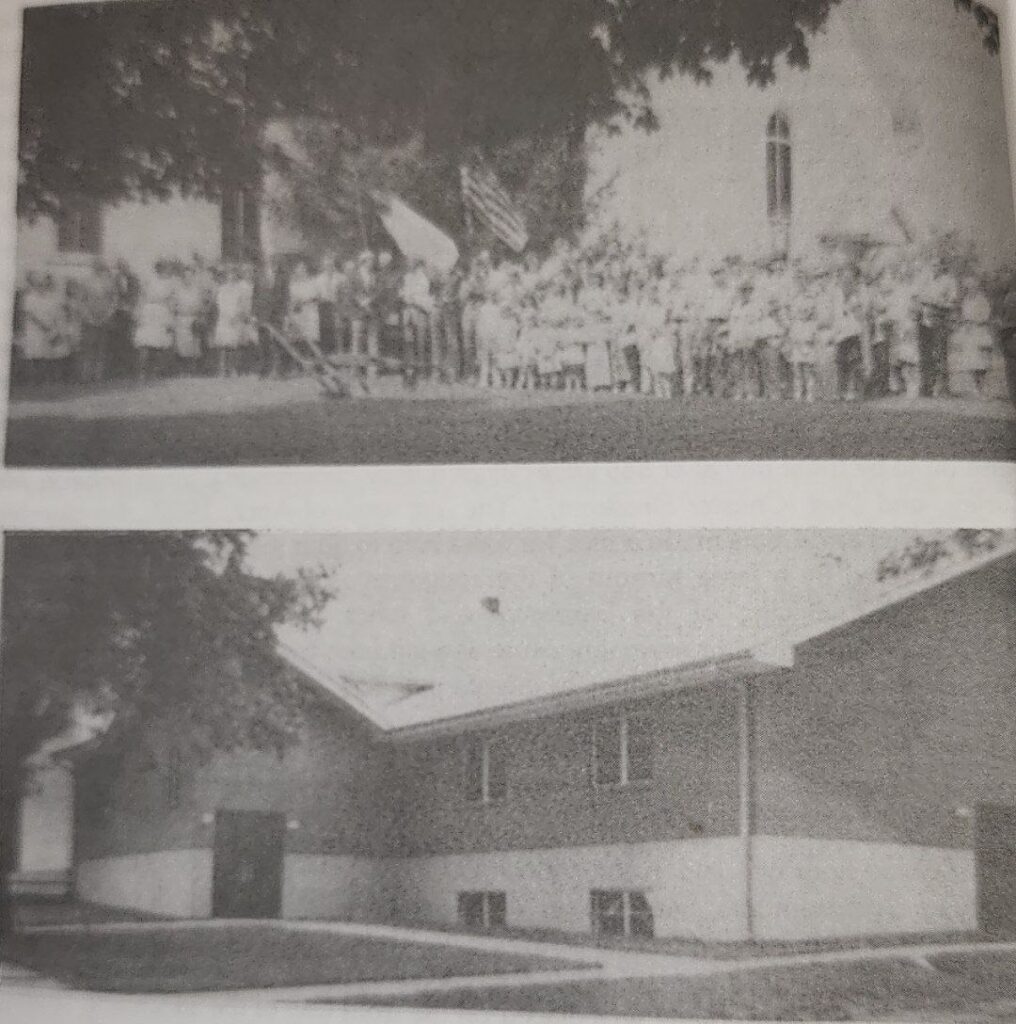
A mortgage burning ceremony was held at the Church on Sunday morning, February 23, 1986. This special service celebrated the paying off of the debt on the new educational wing that was started in 1973. Those serving on the building committee were trustees Oliver Hibschman, Syracuse; Bill Stutzman, now living in Sarasota, Florida; and Chairman Gerald Secrist, now living in Lima, Ohio.
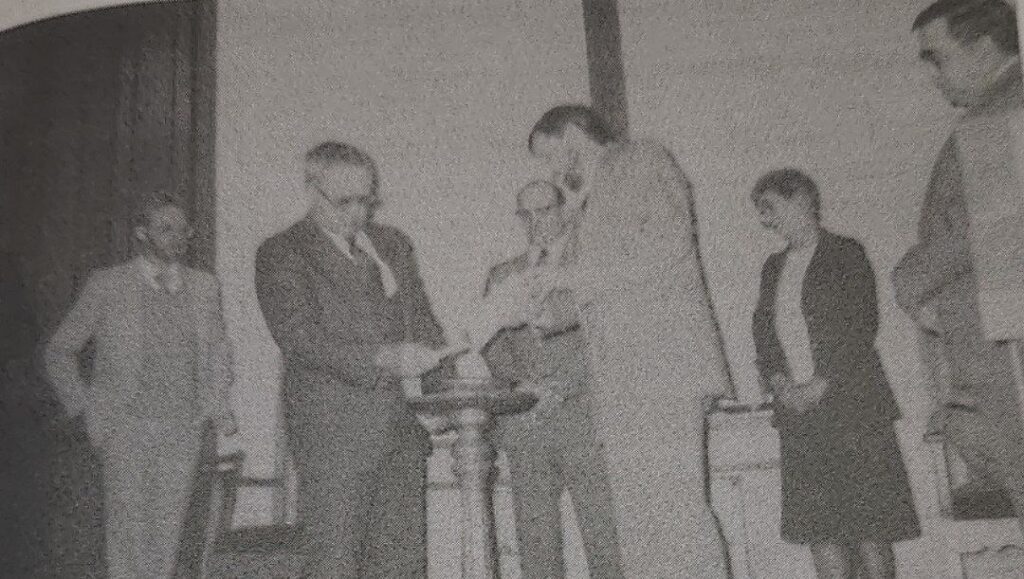
CLOSE CALL
The original structure received a close call near the turn of the century. The area known as the Pickwick Block at the northwest corner of Main and Huntington Streets caught fire on Sunday afternoon, January 7, 1901. The fire started about 5:00 p.m. and the entire block was destroyed. Ronald and John Sharp’s History of Syracuse states: “some of the shingles on the Hotel LeGrande and the Church of God caught fire from the sparks. Climbing ladders to reach the roofs, the bucket brigades poured water on the roofs to put out the sparks and keep the roofs from catching fire.”
COMMUNITY COOPERATION
Not only did the Church of God share the facility with other Churches in the early days, it also has held combined services. In Ronald and Joan Sharp’s History of Syracuse appears an article which says:
“One of the largest revival meetings in the community was held Sep. 1916, when Rev. Claude Gunder came to town, The Churches of the community built a temporary tabernacle to house 1000 people. It was located at the corner of Henry and Huntington Streets (on school property).
The 56 x 90 foot frame building was constructed with boards borrowed from the lumber company. Labor for the project was donated by members of the four churches participating – Evangelical, Methodist, United Brethren, and Church of God.
After the five-week revival the building was dismantled and the boards returned to the lumber company. There is no record as to how many people were converted and taken into church membership due to the revival.“
Community Cooperation Today
As a member of the Syracuse Ministerial Association, the Church of God participates in the annual Union Lenten and Easter Services which are held in the various member Churches in the community. During the summer months a “boat in” worship service is conducted by the Ministerial Association from the deck of a pontoon at Oakwood Park. Summer visitors to the lake have an opportunity to attend services by dropping anchor at Oakwood and listening to the hymns and preaching from the pontoon. A “food pantry” is made available to the needy of the area and is sponsored by the Association. The groceries are stored at the Church of God.
THE PARSONAGES
The first parsonage of the Church of God, according to old Church records, came into existence around 1874. Land was purchased at what is now 207 West Washington Street. This was lot 12 in the McConnell and Lapes addition to the town of Syracuse. Problems developed; in December, 1875, a meeting was held and reported “in examination of the deed of the parsonage property there was found a deficiency in said deed.“
The Church then proceeded to elect three trustees to take charge of said property. Trustees elected were John Gordy, Zebidee Widner and W. J. Brady. Evidently the deed problem was solved because a parsonage was built. Next in the records is numerous mentionings of securing monies for the building fund to retire the debt on the parsonage. A meeting was held December 8, 1877 and a report was given on the matter of subscriptions to the parsonage fund. Brother Francis Brady stated that no money had been collected “but some ready to pay, some not able to pay.” Mr. Brady made a motion that the parsonage be sold to pay the indebtedness. The motion did not carry and Brady along with Brother Framton and Jacob Keller was appointed as a committee to collect money and pay out the parsonage debt. On December 29 of the same year a meeting was called concerning the parsonage debt and it was suggested that money be collected “by pursuasion or if not it should be collected by the law!” A motion was made and passed that money be borrowed to pay off the parsonage debt. The brethren on the Syracuse circuit would be solicited to sign a joint note for the same.
No Money
As the Church went into the new year another meeting was held on January 12, 1878. “The committee on borrowing money reported no money to borrow.” Committee to collect money reported “twenty-six dollars and nineteen cents collected. Some willing to pay as soon as they get it. Some refuse to pay.” The records do not show when or how the indebtedness on the parsonage was finally resolved. We do know in May of 1905 that the parsonage property was sold to Mr. William Moore, who was an elder in the Church.
Our Present Parsonage
At the death of “Will” Moore, a property owned by him at 218 North Huntington Street was willed to the Church in 1913. This property has been used as a parsonage since the Church began employing full time ministers who were not serving on a circuit. Rev. Harry Collins was the first pastor to occupy the parsonage in 1914.
Today this house at 218 North Huntington after receiving an extensive remodeling in the late 1960’s, is still serving as the living quarters for ministers assigned to the Syracuse work.
AND THERE WAS LIGHT
The Church of God, in its business meeting of January 7, 1905, extended a “heart-felt thanks — — to Bro, Moore for lighting the house.” The kerosene lamps were now history and electric lights were put into use at the Church.
THE WILLIAM MOORE FAMILY
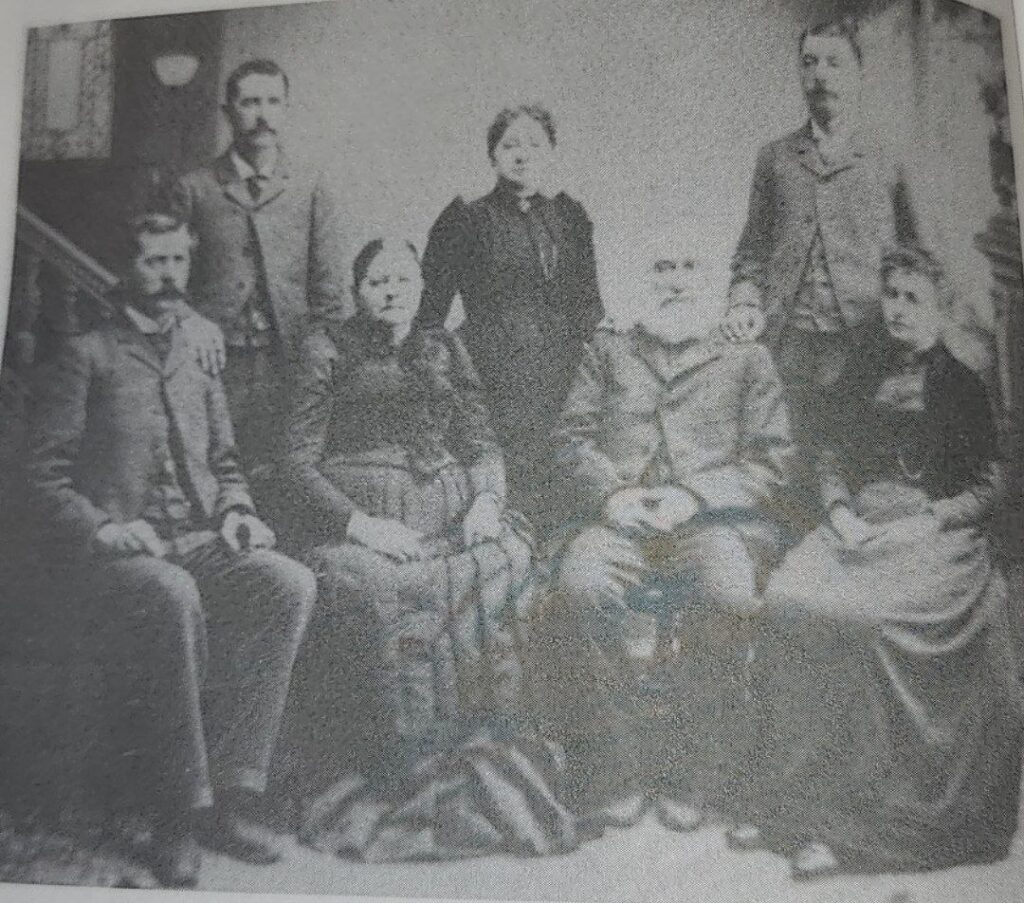
Row 1 – Joseph Moore, Catherine (Weaver) Moore, William Moore Sr., Martha (Moore) Ott.
Row 2 – John Fremont Moore, Elizabeth (Moore) Riddle, William Moore Jr.
William Moore Sr. is remembered as the one who donated the property at 218 N. Huntington to the Church, which is now used as the parsonage. Mr. Moore was also responsible for having electric lights installed in the Church.
SUNDAY SCHOOL
A non-denominational or Union Sunday School was in existence in Syracuse as early as 1857. An old record book in the Syracuse public library contains the minutes of the early Sunday School.
The minutes are in the handwriting of Zebidee Widner, secretary. After the organization of the Church of God, Mr. Widner became the Church clerk and recorded business meetings for over thirty years; a position he gave up in 1900.
The Union Sunday School began meeting in the Church of God in 1870. By the year 1873, the Church of God organized their own Sunday School. They held their classes on Sunday mornings while the Union Sunday School was conducted on Sunday afternoons. John Gordy, a charter member of the Church of God, served as Superintendent of the Union Sunday School until the organization of the Church of God Sunday School, at which time Mr. Gordy headed the new Sunday School.
One by one the other Churches of Syracuse continued to grow and built their own Houses of Worship and the Union Sunday School disbanded.
Lake View Sabbath School
In 1885 the Church of God Sunday School is listed in the records as the “Lake View Sabbath School.” Mr. J. P. Dolan is named as the Sunday School Superintendent and Chorister. Mr. Dolan also served as a teacher from 1883 to around the turn of the century. Dolan came to Syracuse as a timekeeper on the B & O Railroad. He was a teacher and later principal of the Syracuse public school.
Minutes of the Church of God Sabbath School February 11, 1883 are recorded as follows:
“Sabath school met at usual time.
Supt. in charge. School opened by singing and prayer.
Lesson read in concert. Led by Wesley Brady.
Subject of lesson (none other name)
Officers all present
Male scholars present 35
Female scholars present 42
total present 77
Money collected $1.00
After the close of school the following resolutions were adopted.
(1st) When as Mr. Jacob Kern kindly furnished the hall for the use of the oyster supper held by the Church of God sunday school free of charge. Be it therefore resolved that the school hereby tender to Mr. Kern their sincere thanks for the kindness and that the superintendent is hereby requested to carry this resolution to Mr. Kern.
(2nd) Whereas committee of arrangements for said oyster supper was faithful and diligent in performing duties assigned to them. Be it resolved that the school tender them sincere thanks to said committee for services thus rendered.
Nett proceeds of oyster supper $12.47
- W. Strieby, Secretary“
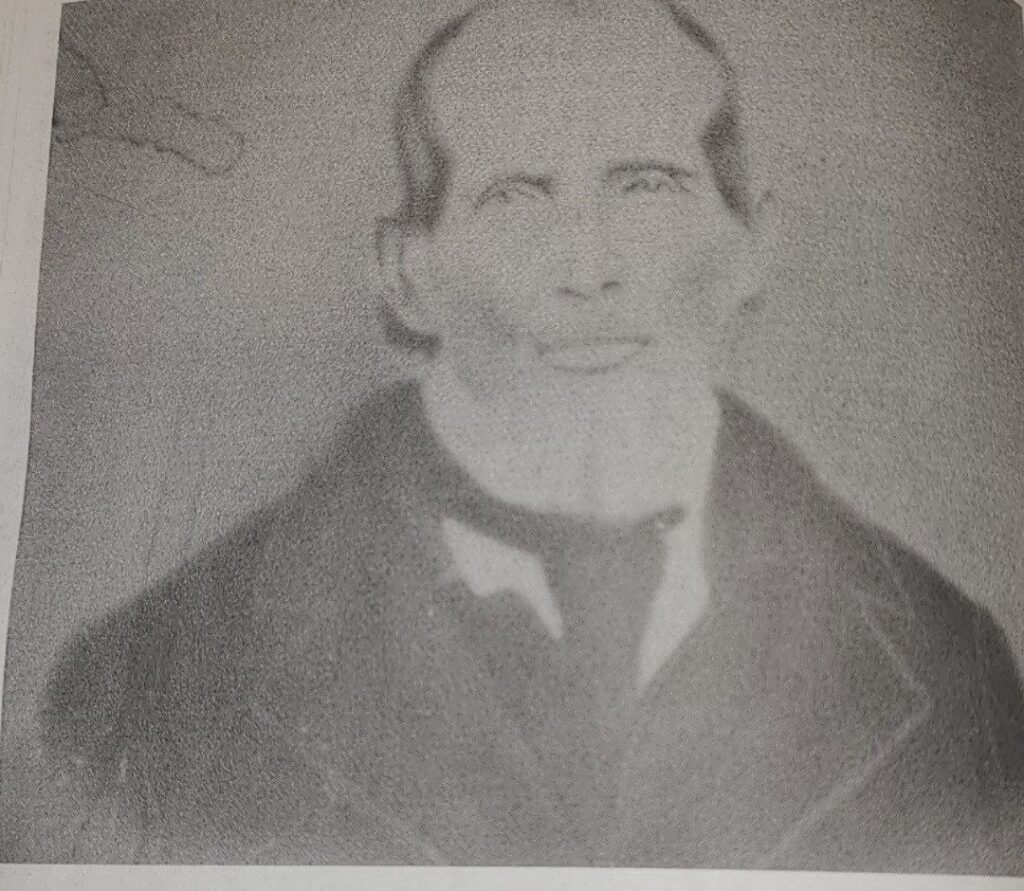
“Mr. Jacob Kern was owner of “the hall” which was located in the 100 block on the south side of East Main Street. Today Mr. Roger Kern and family are members of the Syracuse Church of God. Roger is a great grandson of the Jacob Kern who graciously donated this hall for the Sunday School’s oyster supper in 1883.
Classrooms
In the early days the entire Sunday School met in the sanctuary at the same time. Curtains suspended from tightly stretched wire created “class rooms” for the different age groups. A far cry from our modern educational wing of today.
A Sunday School Lesson leaflet dated May 7, 1882. These leaflets were purchased from the David C. Cook Publishing Co., Chicago, Illinois.
The lesson was for all age groups. The part of the lesson in bold type was for children and the more involved complete story was for adults. The front side of the leaflet stated the title, golden text, appropriate hymn and the “truth”. The back side of the leaflet contained a note to “Mamma”, the lesson story and questions for discussion.
A Sunday School Teacher
The following are excerpts from a letter written to Roxanna Hadley from Violette O’Dell. Violette and her sister Vera were members of the Syracuse Church of God as far back as 1886. We have included parts of the letter written to Roxanna at the time of the Bicentennial of the United States in 1976.
“. . . however, I do remember very distinctly those wonderful Sunday School Days of my childhood and beyond, in that dear, old white Church of God on the hill are among the very fondest of the memories of my life.
My sister, Vera, and I always attended Sunday School as regularly as public day school and I always feel that whatever successes we may have achieved are due in large part to that excellent Christian training, added to the home training by our good, understanding parents.
Despite the many things which I may forget, I shall always remember Mrs. Minerva Benner, my Sunday School teacher in my early childhood days and continuing well into my teens. I can see her yet in my minds eye. She was a rather large motherly looking woman of average height – not to tall but pleasingly plump – with a beautiful face – round, happy, cheerful, patient and expressive – reflecting her shining/christian spirit. She was a devoted Christian and a dedicated Bible student which made her such an inspiring Sunday School teacher.
… She could make the Bible characters come alive and based her teaching on their deeds, good or bad, and explained how and why they were rewarded or punished accordingly. . . . As we grew older we memorized the Lord’s prayer, The Ten Commandments, The Twenty-third Psalm and many beautiful promises found in the Bible. I shall always be grateful to her for this wonderful training which made a lasting impression on my life and taught me a love of the Bible.
When I became old enough but still in my teens, I was assigned as a teacher of a group of eight handsome interesting, young boys in the same Church of God in Syracuse. . . . I cannot remember the names of any of them for sure, with the exception of Roscoe Howard and his brother Wallace, and Clifford Ott.
.. Thank you for giving me this opportunity to participate. It gives me a chance to relive and revive my happy memories of my life and work of so long ago in the Sunday School and church in the Church of God in Syracuse.”
(At the time this letter was written Miss O’Dell was a resident of Westminster Village, Greenwood, Indiana, At 95 she was active in physical fitness, Bible study, lectures, Musical programs and Dominoes.)
Support Organizations
In addition to Sunday School, other groups that involve men, women and children have been organized. The mens prayer breakfast meets early Sunday mornings before the regular services. CGYA (Church of God Youth Advance) meets during the public school year on Wednesday evenings during the mid-week service, WCSC (formerly Mission Circle), the womens organization, meets on the first Thursday of the month.
WHEN THE CIRCUIT RIDER CAME.
In the backwoods of Indiana, in the days of long ago,
When religion was religion, not a dressy fashion show;
When the spirit of the Master fell as flames of living fire,
And the people did the singing, not a trained artistic choir;
There was scarcely seen a ripple in life’s gently flowing tide,
No events to draw the people from their daily toil aside,
Naught to set the pious spirit of pioneers aflame,
Save upon the rare occasion when the circuit rider came.
He was almost always mounted on the sorriest of nags,
All his outfit for the journey packed in leather saddlebags,
And he’d travel with the Bible or the hymn-book in his hand,
Reading sacred Word or singing of the happy, promised land,
How the toiling wifes would glory in the dinners they would spread,
And how many a hapless chicken or a turkey lost its head
By the gleaming chopper wielded by the hand of sturdy dame,
For it wasn’t very often that the circuit rider came.
All the settlement around us would be ringing with the news
That there’d be a meeting Sunday, and we’d “taller” up our shoes,
And we’d brush our homespun dress suits, pride of every country youth,
And we’d grease our hair with marrow till it shone like golden truth,
And the frocks of linsey-woolsey would be donned by all the girls,
And with heated, old firepokers they would make their corkscrew curls;
They were scarcely queens of fashion, but were lovely, just the same,
And they always looked their sweetest when the circuit rider came.
We have sat in grand cathedrals, triumphs of the builders skill,
And in great palatial Churches, ‘neath the organ’s mellow trill,
But they never roused within us such a reverential flame
As would burn in that old school-house when the circuit rider came
Author Unknown
Six men have gone into ministry from Syracuse. They are Rev. Albert Troup, (deceased), Rev. James Hibschman, Rev. Larry Stutzman, Rev. Brad Cox, Matt Price and Tim Yoder.
MINISTERS NOT
PICTURED ARE
1863-1865 – GEORGE THOMAS
1865-1866 – E. BRYAN AND J. SHOCK
1866-1867 – J.S. SHOCK
1867-1870 – GEORGE SMITH
1870-1872 – J.S. SHOCK
1873-1874 – JOSEPH BUMPUS
1874-1875 – MOSES COATS AND JOSEPH BUMPUS
1875-1877 – W.P. SMALL
1877-1880 – ED MILLER
1883-1887 – J.W. MARKLEY
1887-1889 – G.T. KIMMEL
1889-1890 – E. MILLER
1890-1891 – J.F. KLINE AND J.W. STRINGFELLOW
1891-1892 – LOUIS FRETZ AND JOSEPH NEAL
1892-1894 – J.W. MARKLEY
1894-1898 – JOSEPH BUMPUS
1903-1905 – J.W. MARKLEY
1910-1911 – A.O. MUSGRAVE
1911-1912 – REV. McCLELLAN
1927-1928 – G.W. WYATT
1928-1929 – O.O. TRACY
MEMORIES
The Church of God still stands on the hill like a sentinel overlooking the town of Syracuse as it has done for over a hundred years.
Mabel Strombeck McCleary, grandaughter of Charles H. Strombeck, visited the Church of her parentage. To bring this chronicle to a close we would like to borrow from words penned by Mrs. McCleary after her visit.
“I walked into the little church, which is still perfect inside and beautifully kept. The seats were well polished and everything looked as nice as new. I wished to spend hours there as it seemed so full of beautiful memories. I seemed to feel the spirit of my grandparents so very near. Yes, Grandfather had furnished most of the material; lumber made from his own trees had been a big part of its construction and grandfather had done much of the work in its building. This was where the family for years had come to worship; from childhood to adulthood the children had attended there with their parents. Here the family would gather for weddings and here they gathered for the family funerals and those of their friends. I could see Grandma, and it is said she always was there, as well as my Grandfather, sharing their joys and sorrows with the Lord and singing His praises in their faithful Christian living. I was walking the same aisles and sitting in the same seats. I was viewing the same pulpit and standing near the same altar where so often they had knelt to pray. There before me was the very spot where my father and his sisters sang each Sunday in the church choirs. I had been told of this so many times. How much one can live in memories in but a few moments time, but how precious those moments are when spent in the spirit of those we so dearly love.”
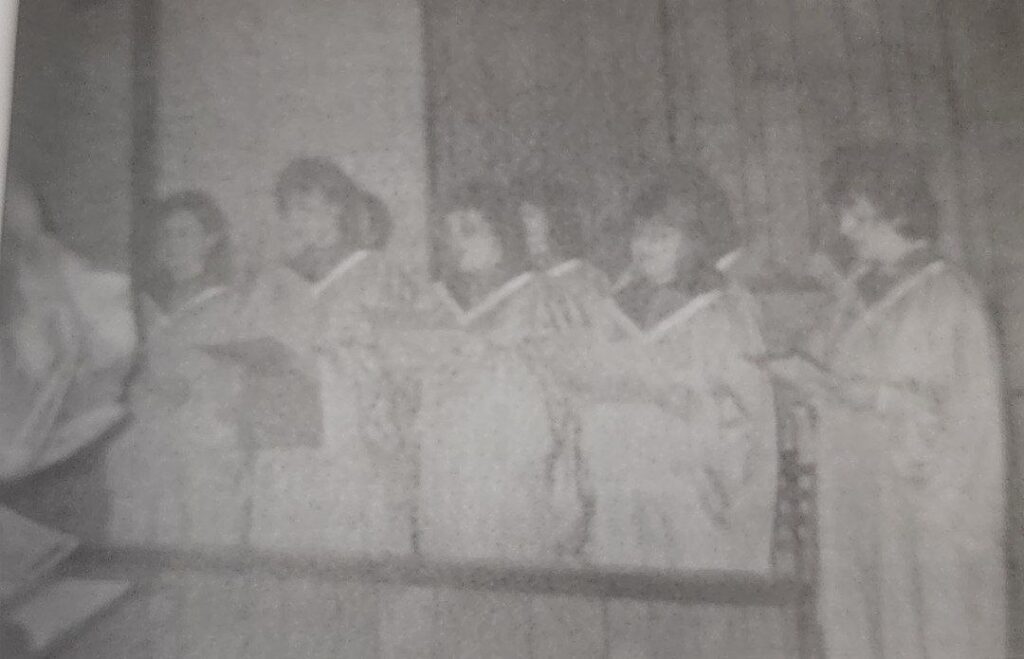
The Legacy Continues
Sancturary Remodel
During the late 2000’s the church decided it was time to refurnish the Sancturary since it had not been updated since the 1970’s. During this remodel they placed new carpet, reupholstered the pews to a tan from a red seat, added stage lights, two projectors and a new sound system. During the remodel the white fake bricks that was behind the cross in the center front of the room was removed. During this removal it was discovered a beautiful painting of Jesus. Unfortunately, no real pictures exist of just this photo but in this phone below you can see if below the pastor.
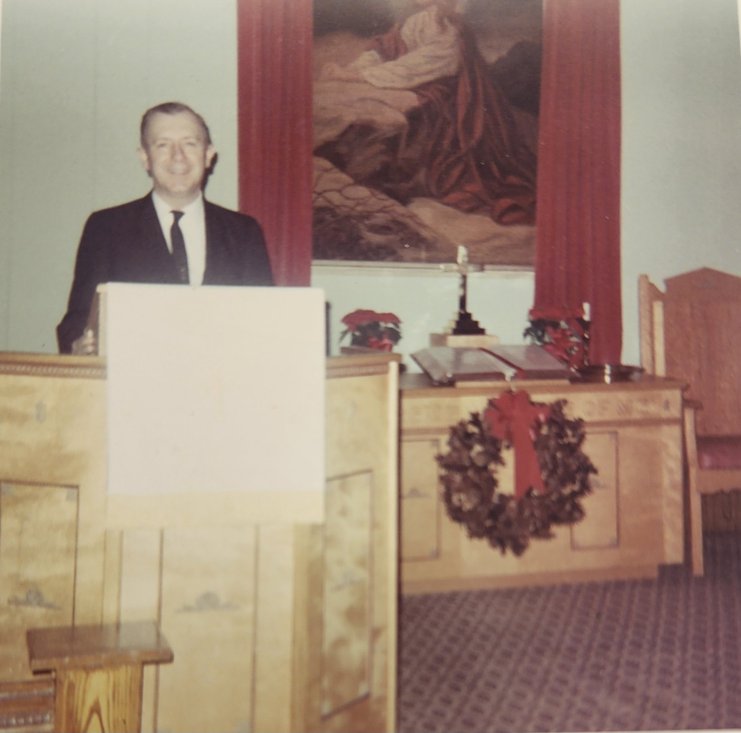
Sesquicentennial 2013
As we anticipate the future and the celebration of 150 years of service to the Lord, we cannot help but pause and remember how we got to where we are today. Much has happened through the years that have helped to mold Syracuse Church of God into the loving and caring body of believers that continues to be united in its mission to spread the Good News of God’s love and gift of salvation.
Highlights of the Last Several Decades
In anticipation of future growth, the church purchased the property directly west of the church building in the late 1980’s. Today that empty lot provides a nice outdoor area for children and adult activities. However, a house stood on the property when first purchased.
In 1991, church members Jackie Plikerd, Nancy Coy, and others founded Teen Parents Succeeding (TPS), a non-profit organization that helps teenage parents stay in school and complete their education by providing low cost childcare, parenting classes, and other support services. The Syracuse Church of God donated the use of the house on that property for TPS’s child care facility. By 2004, TPS had outgrown the building and purchased a new facility that would better serve its needs. With the house standing empty and no further need of it, the church demolished the building in 2005.
The church had also purchased the old “Moore Homer” directly northwest of the church in 1991 and two years later it too was torn down, providing even more space for future needs.
Pastors
During this era from 1989-1991, Ron Bruce served as pastor. He was replaced by Dave Kapaku in 1991 who served until 1996 when he left to pastor a sister church in Fort Wayne. He is now serving in missions in Hawaii. Dr. Sterling DeMond was hired as pastor in 1996, resigned in 1998 when he took over the pastorate of a church in Michigan near his summer home. Harry Gates then came and served as pastor until 2004 when he left to pursue a career in technology. After filling the pulpit for a short while, Vince Wilczynski was voted in as the new pastor in 2004 and served for eight years when he felt called to lead a church in northwest Illinois (Mt Carrol). Stan Owen took over the pastorate in the fall of 2012. Stan retired in April of 2023 and continued to attend the church with the new Pastor Adam Dunlap and wife Julia in September of 2023. Stan was the longest serving Pastor in the history of the Church.
Over the years, pastors’ housing needs have changed with many preferring to make investments in their own homes. Therefore, the old church parsonage was sold in 2001. The proceeds from that sale enabled the church to embark on a major remodeling project. The sanctuary was remodeled and redecorated, along with new technology installed, to provide a more inviting, comfortable, and up-to-date place to worship.
Youth Ministries
Also, in need of an update was the children’s ministry. In 2006, the “Just Kids” program was launched. This Wednesday night program reaches out to community children through Bible teaching, games, crafts, and a filling supper. Hundreds of children have participated in “Just Kids” through the years and have been touched with the saving knowledge of Jesus Christ.
During the 1980s, the church’s pastor Michael Johnson (1981-1989) founded the Syracuse-Wawasee Ministerial Association. Over the years the church has continued to work closely with the association and helped developed the first community-wide Vacation Bible School which began with Market Place AD, an interactive dramatization of Jesus’ ministry. Since then, the churches of the community band together each summer to sponsor Vacation Bible School with different churches taking turns hosting the event. In 2011 and 2012, the Syracuse Church of God hosted the Syracuse-Wawasee Ministerial Association’s Community-Wide Vacation Bible School and plans are underway to host it again in 2013.
Middle school and senior high youth Bible Quiz teams participated in National Bible Quizzing from 1999 to 2010.
Adult Ministries
The ladies of the church remained active in conference WCSC until the early 1990’s, then shifted their focus to a women’s Bible study that was open to all women of the community. Church member Pauline Firestone began a daytime Bible study group, and then later opened her home to host an evening class to accommodate the needs of working women. Eventually Pauline moved to Mishawaka to be near her son and Penny Plikerd continues to lead the Ladies Bible Study. The men of the church were actively involved in Promise Keepers, a nationwide Christian men’s ministry, from the 1990’s until 2000. Today, a men’s breakfast is held regularly.
Outreach Ministries
During the Michael Johnson’s pastorate in the 1980’s, the church, working with the Syracuse-Wawasee Ministerial Association, was instrumental in establishing the Syracuse Food Pantry to serve the needs of area families. The church housed the food pantry until around 1999-2000 until its growth forced its move to another location. Today, the church continues to support the Syracuse Food Pantry with food donations.
The church’s ministry has gone beyond our community to touch people in other countries. In 2010 the church sent its first mission team in 25 years outside the United States. Joe Hibschman, Penny Plikerd, and Pastor Vince Wilczynski went to Haiti for short-term mission work. The following year, DeeAnn Wilczynski joined a short-term mission team to Haiti, and later Pastor Vince Wilczynski made a return trip with his daughter Hannah.
The church also participated in Operation Christmas Child, sending well over 100 shoe boxes filled with toys, school supplies, clothing, and personal care items to needy children around the world. The church stopped this program in 2022 when church numbers slowed.
New Constitution
As needs continued to change and evolve, it was soon realized that the church needed a new constitution that would enable us to streamline the administrative council and provide more efficient governance. A committee was formed to draft a new Church Constitution. The congregation approved the new constitution at the fall congregational meeting in 2008.
Building Needs
Building maintenance is imperative in order for a church body to function productively and provide a comfortable, safe place for believers to worship. In 2010, a new roof was installed over the entire church building.
The congregation had been concerned for many years about the lack of handicap accessibility for those in wheelchairs and with mobility problems. Although the church installed a handicap ramp in the 1970’s that provided access to the sanctuary, the basement was inaccessible to those who could not maneuver the stairs. This prevented some in our church family from fully participating in the life of the church. In 2012, the church took a leap of faith, took out a loan, and installed a handicap lift that provides access from the first floor to the basement. The church is currently in the process of paying off that loan and trusting God for His provision.
Looking Towards the Future
During the years we have been blessed as a church in many ways. Many people have found their Savior at the altar of the Syracuse Church of God. Many children have had their lives molded in our Sunday school classes and “Just Kids” program. Adults continue to grow in knowledge and faith as they study the Gospel with other believers and reach out to the lost. We are excited about what God has planned for the future. Our mission continues to be sharing the message of salvation and ministering to the spiritual, emotional, and physical needs of our church family, community, and the world…
Until Jesus returns!

